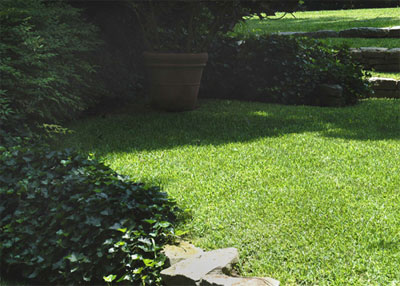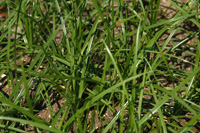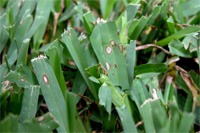Summer Lawn Care

Summer isn’t always kind to Texas turfgrasses. Heat and drought combine to put lawns through real struggles. Here are some simple guidelines to help you – and your grass – survive summer intact.
Common bermuda should be fertilized every 8 weeks (dwarf hybrid bermudas more often, but with lighter doses at each feeding). Use a high-nitrogen or all-nitrogen lawn food, very preferably one that does not have a weedkiller included. Mow it at 1-1/4 to 1-1/2 inches, and mow on 4- or 5-day intervals to keep the grass low and spreading. If you find that the grass is brown for 2 or 3 days after you mow, consider raising the mower one notch (but not above 1-3/4 inches). That browning is because you have been mowing down into stem stubble. Raising the blade will help. However, you will need to remember to drop the blade down that same notch in late winter next year so that the grass doesn’t become gradually taller.
If you have weeds in your bermuda lawn use the appropriate herbicide(s) to control them. Apply a broadleafed weedkiller (containing 2,4-D) for the non-grassy weeds, and apply MSMA to control grassy weeds such as dallisgrass, crabgrass and grassburs. Use Image or Sedgehammer to eliminate nutsedge ("nutgrass"). Read and follow label directions carefully.
St. Augustine is a tropical grass that loves the heat. It also does its best in the sun. Many of us use it, however, because of its tolerance of shade. While bermuda and other grasses need 6 to 8 hours of sunlight daily, St. Augustine can thrive on as few as 4 hours. St. Augustine is the dominant grass of all the types we have at our disposal. As such, it will crowd its way into all other types of grasses.
Fertilize St. Augustine in early summer, then wait until mid-September to feed it again. Gray leaf spot (a fungal disease) can be an issue in the hottest part of the summer when you apply nitrogen to it. If it does show up, apply a labeled fungicide to stop its spread. Watch, too, for chinch bugs. They will leave sunny, hot areas of the lawn dry-looking, even after you water. They’re small, black insects with white diamonds on the backs of their wings. You’ll be able to see them at the interface of dying grass and healthy grass on the hottest summer afternoons. Lawn insecticides will control them.
If you have nutsedge in your St. Augustine, apply Image or Sedgehammer as mentioned for bermuda. If you have dallisgrass, you’ll either have to spot-treat with a glyphosate herbicide or hand-dig the weed. MSMA cannot be used in St. Augustine turf. In fact, you can actually use MSMA to eliminate invading St. Augustine from bermuda lawns.
Zoysias are warm-season grasses, and, as such, can be handled similarly to bermuda and St. Augustine. Feed your lawn now and again in very early fall. Mow as needed and at the height recommended for the variety you’re growing. There are scores of varieties, so ask questions of your turf vendor. Some are intended to be mowed very short, while others must be allowed to grow taller, to 2 or 2-1/2 inches.
Buffalograss grows slowly. It also requires a lot less maintenance than the other grasses, and it’s drought-tolerant to boot. However, bermuda invades it and cannot be controlled. In areas where we have turf or native stands of bermudagrass nearby, buffalograss will probably never become mainstream so long as we have no herbicide that will eliminate bermuda without harming the buffalograss.
Fescues look their worst over the summer. That’s because they are "cool-season" grasses that gear up and start growing in late September and October, then breeze through the winter and into mid-spring, before Texas’ hot season takes its toll. Apply ample water regularly. Avoid all plant foods until fall. Make plans to overseed every September to keep fescue lawns full and dense. For the record, fescues are better suited to Northwest Texas, where summer evenings are somewhat cooler.




